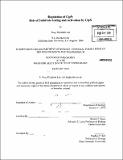Regulation of ClpP : role of substrate gating and activation by ClpX
Author(s)
Lee, Mary Elizabeth, Ph. D. Massachusetts Institute of Technology
DownloadFull printable version (11.01Mb)
Alternative title
Role of substrate gating and activation by ClpX
Other Contributors
Massachusetts Institute of Technology. Dept. of Biology.
Advisor
Robert T. Sauer.
Terms of use
Metadata
Show full item recordAbstract
AAA+ self-compartmentalized proteases are an important class of proteome regulators that operate to selectively degrade protein substrates. All of these enzymes share the architectural theme of a hexameric ring unfoldase stacked axially onto a barrel-like peptidase, with six- or seven-fold symmetry and sequestered active sites. ClpXP is a model self-compartmentalized protease composed of the regulator ClpX and the serine protease ClpP. Proteolysis occurs by ClpX-dependent substrate selection, unfolding, and translocation into the degradation lumen of ClpP, where rapid and relatively non-specific peptide hydrolysis generates small peptide products. Prior work had shown that ClpP is unable to degrade polypeptides in the absence of ClpX, suggesting the existence of a mechanism that inhibits the activity of free ClpP. Structures of free ClpP show active sites geometrically competent to perform peptide-hydrolysis chemistry. However, some biochemical results suggested that N-terminal ClpP residues, which line the axial entrance pores, allosterically regulate these active sites. Through measurements of ClpP active-site reactivity, degradation of size-varied peptides, and mutagenesis of the N-termini, I found that peptide degradation is inhibited by steric occlusion, maintained by the N-terminal 3-stem loop and a-helix A of ClpP. The N-termini also participate in specifying substrate choice, as mutations within the axial channel prevent degradation of peptides containing stretches of charged amino acids. These data support a model in which ClpX binding opens the axial pore of ClpP to facilitate polypeptide translocation. (cont.) Additional residues in ClpP that are important for its function were identified by a selection for dominant-negative mutants impaired in ClpXP-dependent proteolysis. Biochemical studies and mapping of these mutations onto the structure of ClpP suggest that these variants are defective in tetradecamer assembly, peptide binding at the active sites, and ClpX binding. This work provides a foundation for further investigations of the mechanisms of ClpP assembly, degradation, and interactions with ClpX.
Description
Thesis (Ph. D.)--Massachusetts Institute of Technology, Dept. of Biology, 2010. "January 2010." Cataloged from PDF version of thesis. Includes bibliographical references.
Date issued
2010Department
Massachusetts Institute of Technology. Department of BiologyPublisher
Massachusetts Institute of Technology
Keywords
Biology.